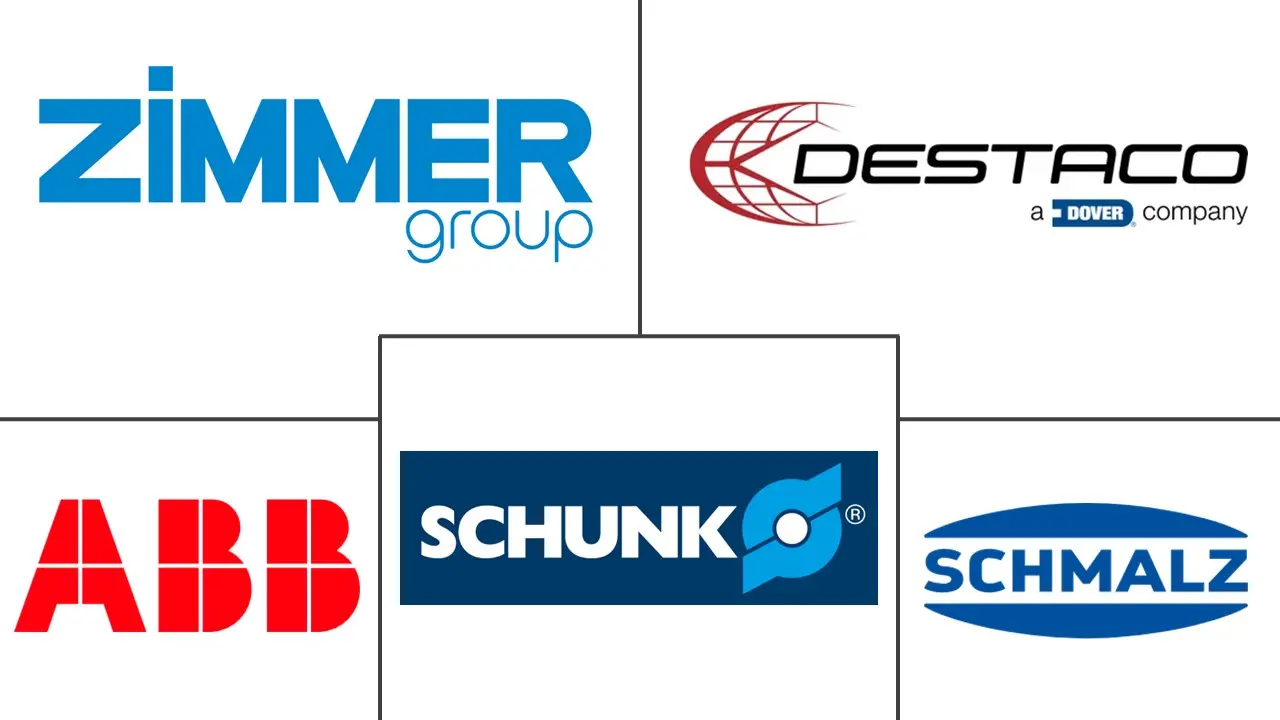Robot End Effector Market Size and Share
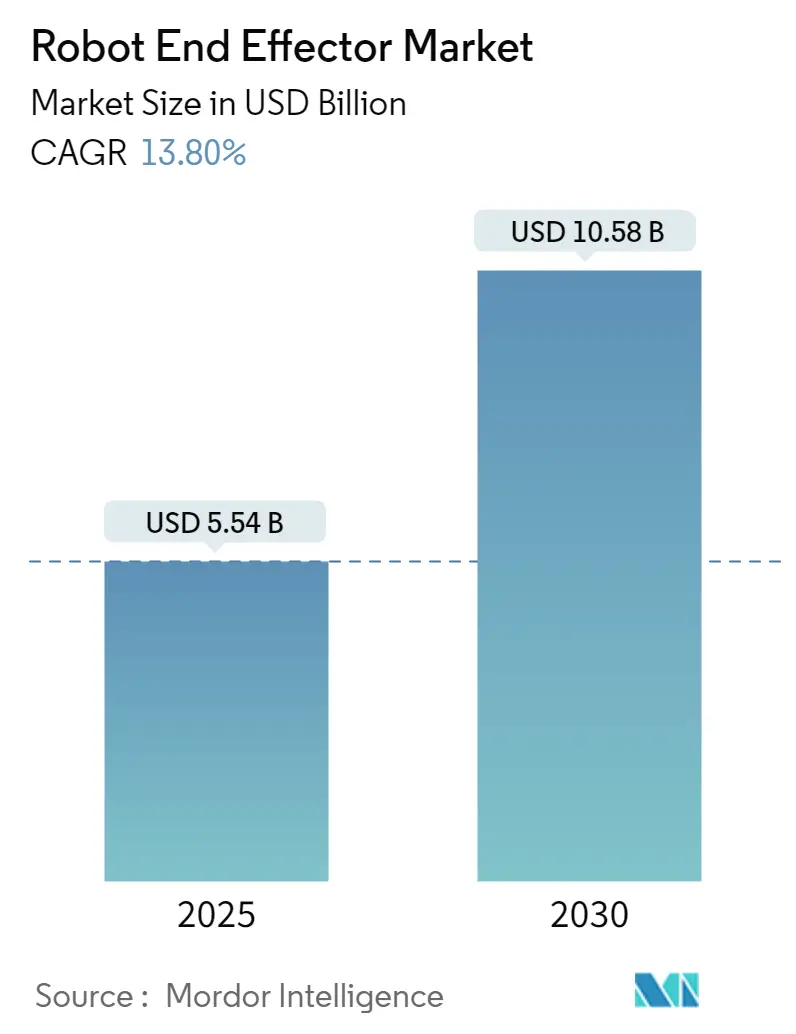
Robot End Effector Market Analysis by Mordor Intelligence
The Robot End Effector Market size is estimated at USD 5.54 billion in 2025, and is expected to reach USD 10.58 billion by 2030, at a CAGR of 13.8% during the forecast period (2025-2030).
The robot end effector industry is experiencing transformative changes driven by the convergence of advanced technologies and industrial modernization. The integration of artificial intelligence, the Internet of Things, and advanced computing capabilities is facilitating the development of next-generation smart factories. According to recent industry data, global industrial robot shipments reached 0.59 million units in 2023 and are projected to expand significantly to 0.71 million units by 2026, highlighting the growing adoption of automation technologies across industries.
The automotive sector continues to lead innovation in robotic automation, demonstrating the evolving sophistication of industrial robot end effector applications. The industry maintains the largest operational stock of industrial robots globally, with approximately one million units representing about one-third of total installations across all sectors. In March 2024, BMW made a groundbreaking move by signing an unprecedented deal to employ humanoid robots in its factories, marking a significant shift from traditional industrial robots to more versatile and adaptable solutions.
Asia-Pacific has emerged as the epicenter of industrial automation, particularly in manufacturing and electronics. China's remarkable progress is evidenced by the installation of 290,258 industrial robots in 2022, marking a 5% increase from the previous year. The Washington Information Technology and Innovation Foundation reports that China's workforce has achieved a robot adoption rate 12.5 times higher than initially predicted, demonstrating the region's aggressive pursuit of automation excellence.
Recent technological innovations are reshaping the capabilities of robot end effector across various applications. In March 2024, Bota Systems AG launched the SenseONE T5, a sophisticated force-torque sensor for collaborative robots with small payloads, offering unprecedented sensitivity levels of 0.05 N / 0.002 Nm. Similarly, Plus One Robotics introduced a revolutionary robot gripper design for parcel induction, utilizing advanced AI technology through their Pick One vision software, demonstrating the industry's rapid advancement in precision and adaptability.
Global Robot End Effector Market Trends and Insights
Automation of Industrial Operations
The acceleration of industrial automation has become a fundamental driver of the robot end effector market, transforming traditional manufacturing processes into highly efficient, automated operations. In the last couple of years, manufacturing leaders have increasingly focused on enhancing their processes to drive greater throughput and reduce costs, particularly through the implementation of Industry 4.0 technologies. According to the Bank of America, by 2025, approximately 45% of all manufacturing operations are expected to be performed by robotic technology, highlighting the significant shift toward automated solutions.
The integration of collaborative robots (cobots) and human workers has revolutionized industrial operations, particularly in labor-intensive and repetitive workload environments. Major corporations are actively embracing this transformation, as evidenced by recent developments. In March 2024, Mercedes-Benz announced the integration of Apptronik's Apollo humanoid robots into its factories for inspecting vehicle parts and managing assembly line operations. This implementation demonstrates the evolving sophistication of robot manipulator end-effectors in handling complex tasks while maintaining operational flexibility. The trend is further reinforced by developments in various sectors, including e-commerce and logistics, where companies like Amazon have deployed advanced humanoid robots like Digit, capable of walking, crouching, and carrying up to 35 lb (16 kg), significantly enhancing warehouse automation capabilities.
Segment Analysis
Grippers Segment in Robot End-Effector Market
The robot gripper segment continues to dominate the global robotic grippers market, commanding approximately 41% market share in 2024. This significant market position is attributed to the widespread adoption of robot gripper technologies across various industries, including automotive manufacturing, electronics assembly, and general industrial applications. The versatility of grippers, ranging from two-fingered parallel grippers to complex multi-fingered systems, enables them to handle diverse object shapes, sizes, and materials with precision. Advanced features such as force feedback, intelligent grip force control, and compatibility with collaborative robots have further strengthened their market position. The integration of sensors and advanced control systems in modern grippers has enhanced their capability to handle delicate components while maintaining high speed and precision, making them indispensable in automated manufacturing processes.
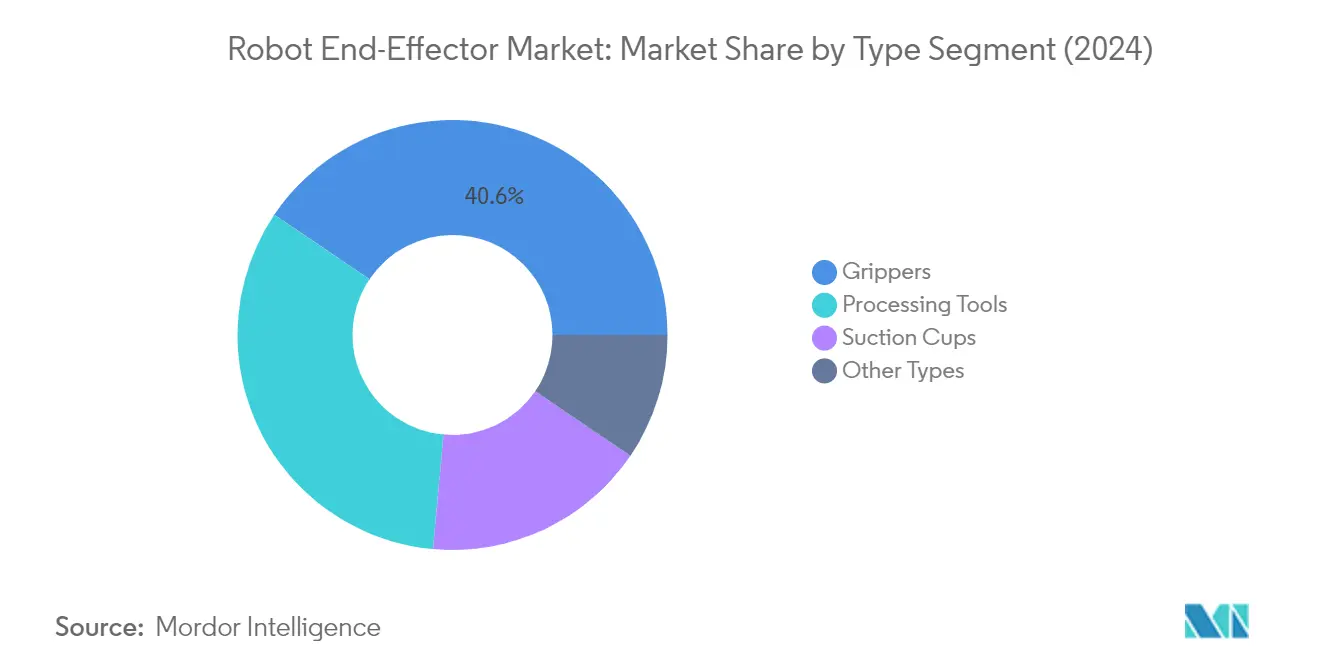
Suction Cups Segment in Robot End-Effector Market
The suction cups segment is emerging as the fastest-growing category in the end effector market, projected to grow at approximately 15% CAGR from 2024 to 2029. This remarkable growth is driven by their increasing adoption in packaging, logistics, and e-commerce applications where flat surface handling is crucial. The segment's growth is further accelerated by technological advancements in vacuum technology, including the development of energy-efficient suction systems and smart robot vacuum gripper systems with integrated sensors. The rising demand for automated material handling in industries such as food and beverage, pharmaceuticals, and electronics manufacturing has created new opportunities for suction cup applications. Manufacturers are focusing on developing innovative suction cup designs with improved durability, better sealing capabilities, and enhanced adaptability to different surface conditions.
Remaining Segments in Robot End-Effector Market by Type
The processing tools and other types segments complete the types of end effectors in robotics landscape, each serving specific industrial applications. Processing tools, including welding guns, paint sprayers, and cutting tools, play a crucial role in manufacturing operations, particularly in automotive and metal fabrication industries. The segment's growth is driven by the increasing automation of processing operations and the development of more sophisticated tool designs. The other types segment, encompassing specialized end-effectors like robot magnetic gripper and hybrid systems, caters to niche applications and specific industry requirements. These segments continue to evolve with technological advancements, particularly in areas such as sensor integration, material science, and control systems.
Segment Analysis: By End-User Industry
Automotive Segment in Robot End-Effector Market
The automotive segment has emerged as a dominant force in the end effector market, commanding approximately 26% market share in 2024. This significant market position is driven by the extensive adoption of robotics and automation in critical automotive manufacturing processes, including welding, painting, milling, cutting, machine tending, and parts transfer. The segment's growth is further bolstered by major automotive manufacturers increasingly investing in advanced robotic solutions to improve product quality while reducing operational complexity. The implementation of Industry 4.0 initiatives and the rising trend of collaborative robots in automotive manufacturing facilities have created substantial opportunities for end effector deployments. Recent developments in electric vehicle production and the increasing focus on automated assembly lines have further accelerated the demand for sophisticated end effector systems in automotive applications.
E-commerce Segment in Robot End-Effector Market
The e-commerce segment is projected to experience the highest growth rate of approximately 16% during the forecast period 2024-2029. This remarkable growth trajectory is primarily attributed to the increasing automation of warehouse operations and the rising demand for efficient order fulfillment processes. E-commerce companies are rapidly adopting robotic solutions equipped with advanced robot mechanical gripper technologies to streamline their picking, packing, and sorting operations. The segment's growth is further supported by the expanding e-commerce market globally and the need for faster, more accurate order processing capabilities. Recent technological advancements in gripper technologies, particularly in handling various product sizes and materials, have made end effector systems increasingly valuable for e-commerce operations. The integration of artificial intelligence and machine learning with end effector systems has enabled more sophisticated handling capabilities, making them essential for modern e-commerce fulfillment centers.
Remaining Segments in End-User Industry
The food and beverage, pharmaceutical, and other industrial segments represent significant market opportunities in the end effector market. The food and beverage industry's adoption is driven by stringent hygiene requirements and the need for consistent handling of diverse food products. The pharmaceutical sector's implementation is influenced by the demand for precise handling in sterile environments and the need for automated quality control processes. Other industries, including electronics manufacturing, metal processing, and general manufacturing, contribute substantially to the market's diversity. These segments are characterized by unique requirements for end effector applications, ranging from delicate component handling in electronics to heavy-duty material handling in industrial manufacturing, showcasing the versatility and broad applicability of end effector technologies across different industrial sectors.
Geography Analysis
Robot End-Effector Market in North America
The North American robot end-effector market holds approximately 14% of the global robot end-effector market share in 2024, driven primarily by the region's leadership in technological innovation and automation adoption. The United States continues to be the primary growth engine, with significant developments in the automotive, e-commerce, and manufacturing sectors. The region's market is characterized by substantial investments in advanced manufacturing technologies and Industry 4.0 initiatives, particularly in collaborative robotics applications. The presence of major technology companies and robotics manufacturers has created a robust ecosystem for end-effector development and implementation. The market is further strengthened by the increasing adoption of automation solutions in various industries, particularly in response to labor shortages and the need for enhanced operational efficiency. Canada and Mexico are also contributing significantly to the market growth, with their expanding manufacturing bases and increasing focus on industrial automation. The region's strong focus on research and development, coupled with favorable government initiatives supporting advanced manufacturing technologies, continues to create new opportunities for market expansion.
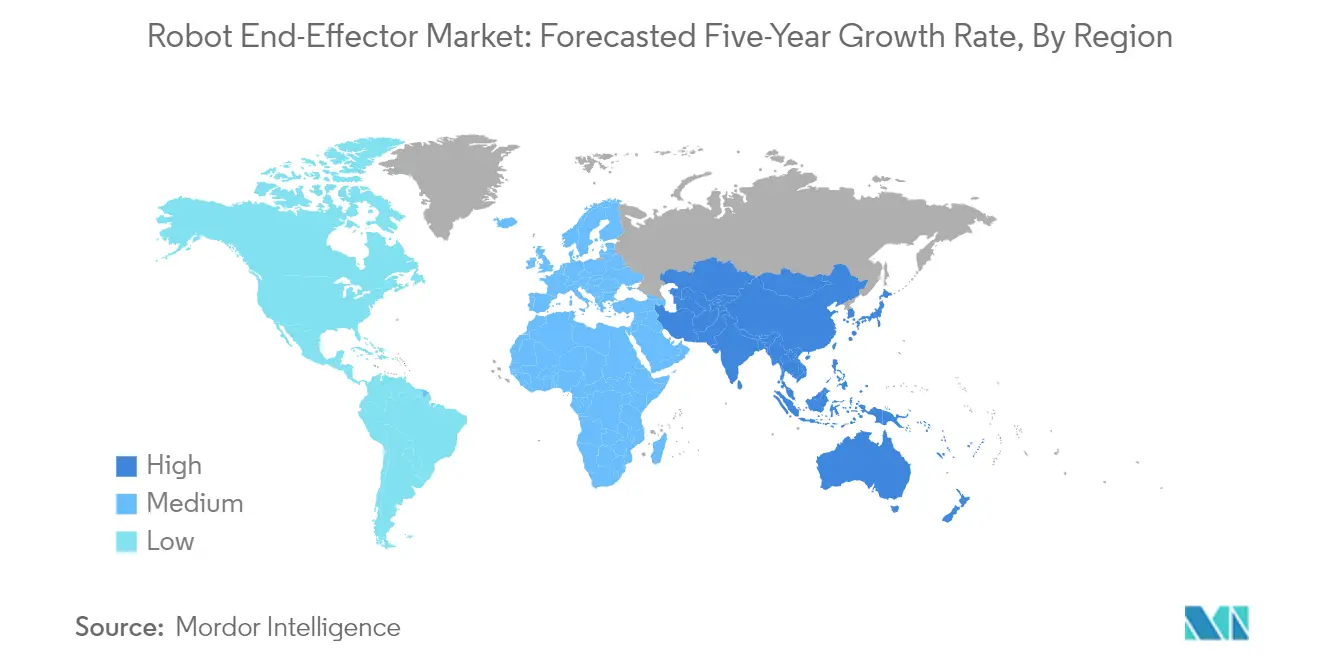
Robot End-Effector Market in Europe
The European robot end-effector market has demonstrated robust growth, with an approximate growth rate of 13% from 2019 to 2024, showcasing the region's strong commitment to industrial automation and Industry 4.0 initiatives. Germany maintains its position as the largest robot market in Europe, leading the region's technological advancement in end-effector solutions. The market is characterized by strong research and development activities, particularly in countries like Germany, France, and Italy, which are at the forefront of innovative end-effector technologies. The region's automotive and manufacturing sectors continue to be major drivers of market growth, with increasing adoption of collaborative robots and smart factory solutions. European manufacturers are particularly focused on developing highly sophisticated end-effectors for robots with advanced sensing capabilities and improved precision. The presence of numerous prominent end-effector manufacturers and research institutions has created a competitive and innovation-driven market environment. The region's strong emphasis on sustainable manufacturing practices and energy efficiency has also influenced the development of next-generation end-effector solutions.
Robot End-Effector Market in Asia Pacific
The Asia Pacific robot end-effector market is projected to grow at an impressive rate of approximately 15% during the period 2024-2029, establishing itself as the most dynamic region in the global market. China continues to lead the regional market, driven by its ambitious manufacturing modernization initiatives and strong government support for automation technologies. The region's market is characterized by rapid industrialization, particularly in countries like Japan, South Korea, and India, where manufacturing automation is becoming increasingly critical. The electronics and automotive sectors are primary drivers of market growth, with manufacturers increasingly adopting sophisticated robot end-effector solutions. The region benefits from a strong manufacturing base, competitive pricing, and growing domestic demand for automated solutions. Local manufacturers are increasingly focusing on developing cost-effective yet technologically advanced end-effector solutions to meet the growing demand. The presence of major robotics manufacturers and the continuous expansion of manufacturing facilities across the region further strengthen market growth prospects.
Robot End-Effector Market in Rest of the World
The Rest of the World region, encompassing Latin America, the Middle East, and Africa, represents an emerging market for the robotic end-effector market with significant growth potential. Countries like Brazil, Mexico, and the UAE are leading the adoption of automation technologies in their respective regions. The market is primarily driven by increasing investments in manufacturing automation, particularly in the automotive and electronics sectors. Latin American countries are experiencing notable digital transformation and increasing growth in Industry 4.0 initiatives, while Middle Eastern countries are focusing on diversifying their economies through industrial automation. The region is witnessing growing interest from global manufacturers looking to establish production facilities, particularly in Mexico and Brazil. The emphasis on improving manufacturing efficiency and reducing operational costs is driving the adoption of end-effector solutions. The market is characterized by increasing awareness about the benefits of automation and growing investments in industrial infrastructure.
Competitive Landscape
Top Companies in Robot End-Effector Market
The robot end-effector market features prominent players like ABB, DESTACO, Zimmer Group, SCHUNK, J. Schmalz, Robotiq, KUKA, Weiss Robotics, Piab, and Bastian Solutions, leading innovation and market development. These companies are increasingly focusing on developing advanced gripping solutions incorporating AI and IoT capabilities to enhance precision and flexibility in automated operations. Strategic partnerships with robot manufacturers and system integrators have become crucial for expanding market reach and technological capabilities. Companies are investing heavily in research and development to create end effectors suitable for collaborative robots and Industry 4.0 applications. The market is witnessing a strong trend toward customizable and modular end-effector solutions that can adapt to various industrial applications. Geographic expansion, particularly in the emerging markets of Asia-Pacific, has become a key strategy for market leaders to capture growing automation opportunities.
Market Structure Shows Dynamic Competitive Environment
The robot end-effector market exhibits a mix of global conglomerates and specialized manufacturers, creating a diverse competitive landscape. Large industrial automation companies leverage their extensive distribution networks and comprehensive product portfolios to maintain market dominance, while specialized players focus on niche applications and innovative technologies. The market structure is characterized by ongoing consolidation through strategic acquisitions, particularly as larger companies seek to acquire innovative technologies and expand their application expertise. Regional players, especially in emerging markets, are gaining prominence by offering cost-effective solutions tailored to local manufacturing needs.
The competitive dynamics are shaped by varying levels of vertical integration, with some companies manufacturing complete robotic solutions while others specialize in specific end effector technologies. Market participants are increasingly forming strategic alliances to combine complementary capabilities and enhance their market presence. The industry has witnessed significant merger and acquisition activities, particularly focused on acquiring companies with advanced gripping technologies or a strong presence in growing application segments. Companies are also establishing innovation centers and manufacturing facilities in key markets to strengthen their competitive position and better serve local customers.
Innovation and Adaptability Drive Future Success
Success in the robot end-effector market increasingly depends on companies' ability to develop versatile solutions that can address evolving manufacturing requirements. Market leaders are focusing on expanding their product portfolios with smart end effectors featuring advanced sensing capabilities and improved connectivity. Companies are investing in developing end effectors that can handle varying product sizes and materials, which is particularly important in industries like e-commerce and food processing. The ability to provide comprehensive support services, including installation, maintenance, and technical consulting, has become crucial for maintaining market position.
Future market success will be determined by companies' ability to address growing demands for sustainability and energy efficiency in manufacturing operations. Manufacturers need to focus on developing lightweight materials and energy-efficient designs while maintaining robust performance capabilities. The increasing adoption of collaborative robots presents opportunities for companies to develop specialized end effectors that ensure safe human-robot interaction. Regulatory compliance, particularly in sensitive industries like food processing and pharmaceuticals, will continue to influence product development strategies. Companies must also maintain flexibility in their supply chains and manufacturing operations to respond quickly to changing market demands and technological advances.
Robot End Effector Industry Leaders
-
ABB Group
-
DESTACO Europe GmbH
-
Zimmer Group
-
Schunk GmbH
-
J. Schmalz GmbH
- *Disclaimer: Major Players sorted in no particular order
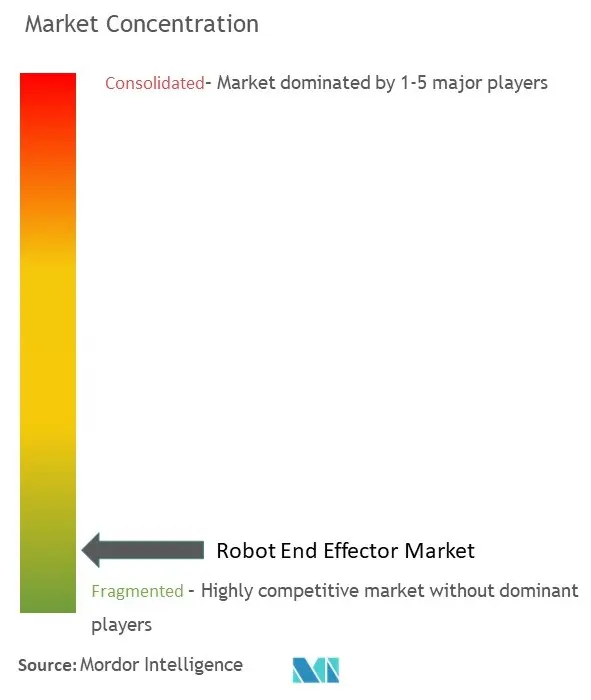
Recent Industry Developments
- February 2024: SCHUNK enabled automatic finger change during the ongoing process with the new BSWS-R jaw quick-change system. The cleverly designed system consists of just a few components and is compatible with all grippers with a PGN-plus-P screw connection diagram. The BSWS-R is the next stage of the evolution of the BSWS series from SCHUNK.
- September 2023: Piab added four new cups to its automotive suction cup series. The new cups extend the PAF (Piab Automotive Flat) and PAB (Piab Automotive Bellow) families with two new sizes each - Ø100mm and Ø125mm. The suction cup assortment comprises 60 shores (A) silicon-free Nitril-PVC, creating a durable, cost-effective product. The automotive suction cups have friction cleats to withstand shear forces during operation.
Global Robot End Effector Market Report Scope
End-effectors are peripherals connected to robot arms. These are specifically designed to perform tasks such as picking, moving, and placing dry or prepreg reinforcements, as well as perform industrial process requirements such as painting and welding, to name a few. The robot end-effector market is defined in terms of the revenue accrued by the vendors' products offered in the market.
The robot end-effector market is segmented by type (grippers, processing tools, suction cups, and other types), by end-user industry (automotive, food and beverage, e-commerce, pharmaceutical, and other end-user industries), by geography (North America, Europe, Asia-Pacific, and the rest of the World). The report offers market forecasts and size in value (USD) for all the above segments.
| Grippers |
| Processing Tools |
| Suction Cups |
| Other Types |
| Automotive |
| Food and Beverage |
| E-commerce |
| Pharmaceutical |
| Other End-user Industries |
| North America |
| Europe |
| Asia |
| Australia and New Zealand |
| Latin America |
| Middle East and Africa |
| By Type | Grippers |
| Processing Tools | |
| Suction Cups | |
| Other Types | |
| By End-user Industry | Automotive |
| Food and Beverage | |
| E-commerce | |
| Pharmaceutical | |
| Other End-user Industries | |
| By Geography*** | North America |
| Europe | |
| Asia | |
| Australia and New Zealand | |
| Latin America | |
| Middle East and Africa |
Key Questions Answered in the Report
How big is the Robot End-Effector Market?
The Robot End-Effector Market size is expected to reach USD 5.54 billion in 2025 and grow at a CAGR of 13.80% to reach USD 10.58 billion by 2030.
What is the current Robot End-Effector Market size?
In 2025, the Robot End-Effector Market size is expected to reach USD 5.54 billion.
Who are the key players in Robot End-Effector Market?
ABB Group, DESTACO Europe GmbH, Zimmer Group, Schunk GmbH and J. Schmalz GmbH are the major companies operating in the Robot End-Effector Market.
Which is the fastest growing region in Robot End-Effector Market?
Asia Pacific is estimated to grow at the highest CAGR over the forecast period (2025-2030).
Which region has the biggest share in Robot End-Effector Market?
In 2025, the Asia Pacific accounts for the largest market share in Robot End-Effector Market.
What years does this Robot End-Effector Market cover, and what was the market size in 2024?
In 2024, the Robot End-Effector Market size was estimated at USD 4.78 billion. The report covers the Robot End-Effector Market historical market size for years: 2024. The report also forecasts the Robot End-Effector Market size for years: 2025, 2026, 2027, 2028, 2029 and 2030.
Page last updated on:
